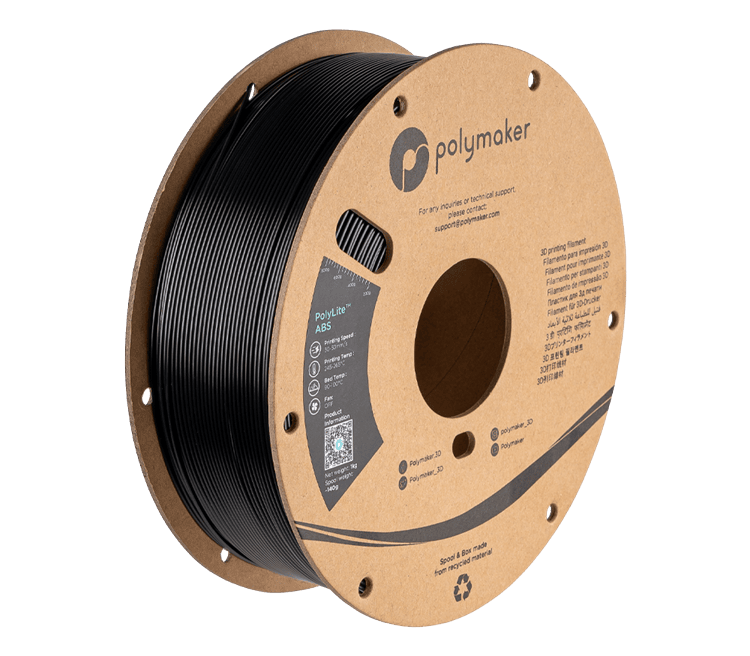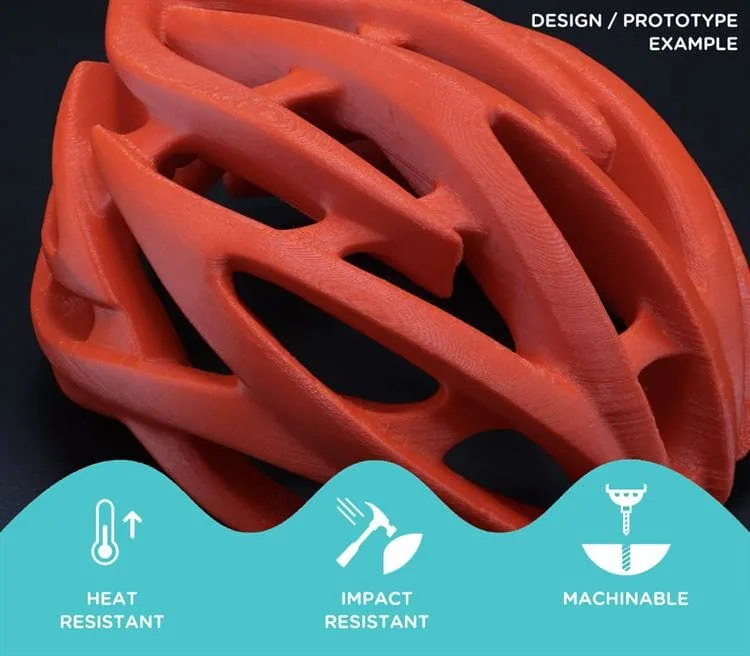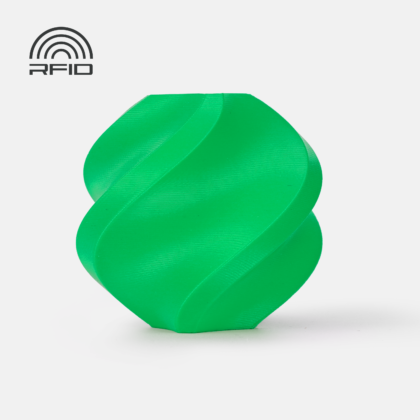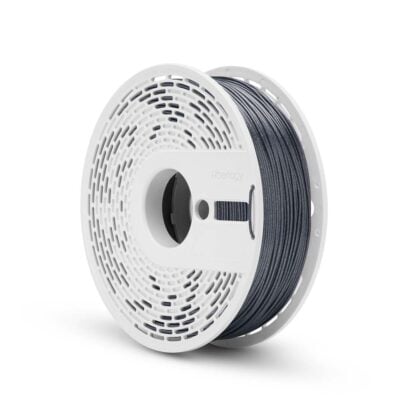PolyLite ABS – black – black – Polymaker
Product Features
- High quality PolyLite™ ABS, which has a significantly lower volatile content than traditional ABS filaments.
- High quality Polymaker ABS with weaker odor.
- Great mechanical strength and durability.
- High heat resistance up to 99℃ HDT.
- Good possibilities for further processing.
- Cardboard spool and packaging (made of 100% recycled cardboard)
- Consistent color and tolerance (1.75 mm diameter +/- 0.03 mm)
PolyLite™ is a family of 3D printing filaments manufactured from the finest raw materials to deliver exceptional quality and reliability. PolyLite™ covers the most popular 3D printing materials to meet your everyday design and prototyping needs. PolyLite™ ABS is made with a special bulk-polymerized ABS resin that has a significantly lower volatile content than traditional ABS resins. It provides excellent print quality with minimal odor during printing.
Functions
- Less odors – PolyLite™ ABS is made from a special bulk polymerized ABS resin that has a significantly lower volatile content than traditional ABS resins. It provides excellent print quality for printing functional parts with minimal and reduced odor during printing.
- Balanced mechanical/thermal properties – Many other brands of ABS filaments contain additives that can reduce the thermal resistance of the filament. PolyLite™ ABS is a “true” ABS filament that features well-balanced mechanical and thermal properties, outperforming conventional PLA and PETG in strength while also featuring heat resistance up to 100°C.
- Excellent print quality – PolyLite™ ABS is capable of printing high quality models and prototypes and is often used for 3D printing production parts. Made from only the highest quality materials, PolyLite™ ABS provides excellent print quality and reliability. A heated bed with a minimum temperature of 90°C is required.
- Uncompromising Quality – With Polymaker’s industry-leading quality control process and rigorous in-house testing, you can be confident that PolyLite™ ABS will produce beautiful, reliable and accurate printed parts.
Comparison of materials
Compare PolyLite™ PLA, PETG, ABS, ASA and PC.
Please note that other product ranges such as PolyMax™ PLA, PETG and PC have different properties compared to the PolyLite™ range.
| PolyLite™ PLA | PolyLite™ PETG | PolyLite™ ABS | PolyLite™ ASA | PolyLite™ PC | |
| Material: | PLA | PETG | ABS | ASA | PC |
| Description: | High hardness PLA | High quality PETG | Durable ABS | UV & weather resistance ASA | Robust PC |
| Nozzle temperature range: | 190°C – 230°C | 230°C – 240°C | 245°C – 265°C | 240°C – 260°C | 250°C – 270°C |
| Pad Temperature: | 25 – 60°C | 70 – 80°C | 90 – 100°C | 75 – 95°C | 90 – 105°C |
| Inclogger | Useful for making large parts | Recommended for the manufacture of large parts | Recommended | Recommended | Highly recommended |
| Heated chamber: | N/A | N/A | Recommended for large parts | Recommended for large parts | Recommended for large parts |
| Hardness: (X-Y) |
High | Moderate | Moderate | Moderate | Top |
| Tensile strength: (X-Y) |
46.6 MPa | 31.9 MPa | 33.3 MPa | 43.8 MPa | 62.7 MPa |
| Durability: (X-Y) |
Low impact strength | Moderate impact force | High impact strength | High impact strength | Low impact strength |
| Glass transition temperature: | 61°C | 81°C | 101.1°C | 97.8°C | 113.4°C |
| Heat deflection temperature: (0.45 MPa) | 59.8°C | 78.4°C | 99.6°C | 102.6°C | 111.2°C |
| Special feature: | – High hardness and strength. – Easy to print, widest printer compatibility, best dimensional stability and lowest temperature requirements. |
– It combines good printability, mechanical properties and heat resistance with better dimensional stability compared to ABS, ASA and PC. | – Balanced mechanical properties, durability and high heat resistance. – Easy to sand, paint and glue. |
– Resistant to UV rays, rain and environmental cracking. – Balanced mechanical properties, durability and high heat resistance. – Easy to sand, paint and glue. |
– High hardness, strength and heat resistance. – Transparent filament for applications that require good light scattering. |
| Popular with: | Total use | Design and functional prototyping | Design, functional prototyping and manufacturing | Functional Prototyping, Manufacturing, Mining, Automotive | Production, Lighting, Fixtures and fittings |
- ABS is one of the earliest and most common 3D printing materials, which retains its popularity for prototyping and additive manufacturing applications due to its low cost, balanced mechanical/thermal properties, and excellent print quality.
- High strength and heat resistance.
- Excellent price compared to other engineering plastics.
- ABS materials are relatively easy to grind.
- Although it is very important for this material to be printed at the appropriate ambient temperature, ABS is an extremely popular and useful choice for low cost and functional applications.
PolyLite™ ABS is a cost-effective material for manufacturing functional parts with high strength, chemical resistance, heat resistance and ductility. With heat resistance up to 100˚C, PolyLite™ ABS can handle the temperature demands of a wide range of applications, offering a durable solution for product manufacturing. Compared to materials such as plain PLA and PETG, PolyLite™ ABS features improved ductility, allowing users to print parts designed with conformable components.
Print settings
| Nozzle temperature: | 245°C – 265°C |
|---|---|
| Pad Temperature: | 90°C – 100°C |
| Surface material for construction: | Works well with most building surfaces, e.g. glass, BuildTak®, etc. Rigid build plates are recommended over magnetic flexible plates. |
| Surface treatment of the plate: | Apply Magigoo Original , PVA adhesive or EcoFixy adhesive to the building surface to improve bonding. |
| Incloser: | Recommended. |
| Heated chamber: | Recommended for some geometries. For higher densities and larger geometries, 70˚C+ is required. |
| Cooling fan: | LOW for better surface quality OFF for better strength |
| Print speed: | 30 mm/s – 50 mm/s |
| Retraction: | The ideal retraction settings vary from printer to printer and depend on the host. The following settings are a good starting point for many machines. Direct drive: 1 mm retraction distance at 20 mm/s retraction speed Bowden: 3 mm retraction distance at 40 mm/s retraction speed |
| Recommended support material: | Self-Support. |
The above printing recommendations are based on a 0.4 mm nozzle. Please note that ideal printing conditions may vary depending on your 3D printer settings. For high-speed 3D printers, be sure to increase the extrusion temperature to use higher print speeds.
ABS filaments benefit from the hot environment. When printing larger or higher density models, it may be beneficial to pre-heat your build plate 20 – 30 minutes prior to printing. In colder climates, a longer preheat time may be helpful.
For other printing tips with PolyLite™ ABS contact us!
Specifications
| Weight: | 1kg |
|---|---|
| Type of material: | ABS |
| Density: | 1.12 (g/cm3 at 21.5˚C) |
| Colour: | Black |
Compatibility
PolyLite™ ABS is designed with compatibility in mind to print perfectly on a wide range of professional 3D printers. This material requires a heated bed and we recommend printing with a case or heated chamber for large or thin models.
Of course, with thousands of unique 3D printer models on the market, we can’t guarantee that every filament type will work with every 3D printer.
Technical data
All test specimens were printed under the following conditions: nozzle temperature = 260˚C, build plate temperature = 110˚C, leachate = 100%, cooling fan = OFF
All specimens were conditioned at room temperature for 24 hours prior to testing.
THERMAL PROPERTIES
| Values: | Test method |
|
| Glass transition | 101.1°C | DSC, 10°C/min |
| Heat deviation temperature | 0.45MPa – 99.6°C 1.8 MPa – 98.2°CHDTCurve |
ISO 75 |
| Vicat softening temperature | 103.9°C | ISO 306, GB/T 1633 |
MECHANICAL PROPERTIES
| Values: | Test method: |
|
| Jung’s Module (X-Y): |
2,246.6 MPa | ISO 527, GB/T 1040 |
| Tensile strength (X-Y): |
33.4 MPa | ISO 527, GB/T 1040 |
| Tensile force (Z): | 29.7 MPa | ISO 527, GB/T 1040 |
| Elongation at break (X-Y): | 17.9% | ISO 527, GB/T 1040 |
| Bending modulus (X-Y): | 2,127.2 MPa | ISO 178, GB/T 9341 |
| Bending force (X-Y): |
56.2 ± 0.3 MPa | ISO 178, GB/T 9341 |
| Sharpie Impact Strength (X-Y): |
18.0 ± 0.9 kJ/m2 | ISO 179, GB/T 1043 |
The typical values presented in the Polymaker data sheet are for reference and comparison only. Due to the nature of 3D printing, they should not be used for design specification or quality control purposes.
STORAGE AND DRYING
- Before packaging, PolyLite™ ABS is dried to ensure the best print quality and the filaments are vacuum sealed to protect them from moisture. When not in use, PolyLite™ ABS should be stored away from sunlight in the packaged resealable bag.
- Like other ABS filaments, PolyLite™ ABS is susceptible to absorbing moisture from the air, which can subsequently affect the quality and mechanical properties of the final prints. We recommend storing PolyLite™ ABS in a PolyBox™ or dry cabinet during printing to prevent moisture absorption, which will reduce print quality. PolyBox™ stores the filament in dry conditions (relative humidity 15% or less).
- If you hear popping sounds and notice that the surface quality of your print is uneven or the color is not consistent, this is a likely indicator that the filament has absorbed too much moisture. PolyLite™ ABS spools can be dried in a preheated convection oven at 70˚C for up to 6 hours. Results may vary depending on the accuracy of your oven, so please use caution. For more information on thread drying, please read our user guide.
FREQUENTLY ASKED QUESTIONS
Q: How does PolyLite™ ABS compare to other ABS materials?
A: Like Polymaker’s other products, PolyLite™ ABS was developed specifically with 3D printing in mind. The raw materials in this material are selected to reduce print odor and maximize performance. Users will also notice when comparing technical data; PolyLite™ ABS is one of the strongest ABS materials on the market, outperforming many other brands.
Q: Do I need a housing to print PolyLite™ ABS?
A: It really depends on the ambient temperature of the room, the size, geometry and infiltration density of your parts. The general rule is that the larger your project, the more important the presence of a housing or heated chamber becomes. When printing without an enclosure, it is important to keep the printer away from cold drafts that can affect the print.
Q: Can I treat PolyLite™ ABS with acetone?
A: In short, yes, PolyLite™ ABS can be smoothed with acetone, although we strongly recommend considering safer alternatives.
WARNING: Acetone is a hazardous chemical that must be handled with proper precautions. This is not a process we recommend, and there are many methods that can pose an unreasonable and serious risk of fire that can cause damage to your health, property and even result in death.
Q: ABS is UV resistant plastic?
A: No, there are some misconceptions, but ABS is not an inherently UV resistant plastic. A high quality ASA filament such as PolyLite™ ASA is better suited for exterior door applications. Alternatively, some users paint their 3D printed ABS parts to provide UV protection.
Q: Can ABS be printed at large scales without warping?
A: A stable high temperature environment is required to print larger ABS parts without deformation. Whether a part is susceptible to deformation depends on how residual stress is released in the geometry of the part. Most users print ABS with the heated bed set at 100˚C, with a passively heated surround housing. This effectively reduces internal stresses causing warping or cracking. To ensure that ABS can be printed at any size without warping, 3D printing with a professionally designed heating chamber is required.
Q: Do I need to rewind this thread if I want to use it with another spool?
A: We strongly advise you not to manipulate the product by rewinding. See our article for full information on the risks. All Polymaker filaments are wound with tension but without strain. Rewinding completely rearranges the curvature of the coil and this tension over time can cause most plastics to catastrophically break. If for some reason your printer is blocked from mounting smaller than standard size spools, there may be safe print adapters or external mounting solutions available.
Don’t know where to start? Or which thread would be right for your application? We offer a wide range of support options, including over the phone. Contact us today!
Polymaker is an international team that is passionate about 3D printing. They produce the finest 3D printing materials, controlling every stage of production. With a diverse portfolio of materials ranging from high-performance plastics to unique aesthetic solutions, Polymaker will continue to add cutting-edge materials to their ever-growing portfolio.
At the heart of Polymaker is their research and development lab, where all Polymaker materials are formulated and refined from scratch to create best-in-class 3D printing materials. Their precision testing equipment combines the latest advances in technology to ensure they are ahead of the game.
PolyLite™ ABS, like all other Polymaker materials, is manufactured using state-of-the-art polymer processing technology and equipment. Polymaker’s stringent quality control processes ensure industry standards of reliability for consistent customer service.
Tolerance – Polymakers’ custom-developed extrusion, control and monitoring solutions ensure that filament tolerance and roundness meet Polymakers’ stringent quality standards.
Reliable mechanical, coloring and printing properties – Each batch of filament products is tested to ensure that all quality specifications (melt flow, softening point, mechanical, diameter, roundness) are met.
Drying and Vacuum Sealing – All Polymaker filaments are dried to a moisture level before being packaged < 0.1% to ensure the best print quality, and are vacuum sealed to protect the filaments from moisture. All vacuum packed products are allowed to sit for 24 hours before being boxed to ensure they do not leak.
PolyLite™ ABS is spooled on Polymakers 1kg cardboard spools made from recycled cardboard. The cutout and weight gauge on the side of the spool make it easy to see exactly how much filament is left for your next printing project. The recycled cardboard packaging and cardboard spool of PolyLite™ ABS are the first step taken towards creating more environmentally sustainable products. The spool is packaged in a vacuum-sealable bag to ensure your filament doesn’t get wet. Like all other ABS filaments, PolyLite™ ABS is hygroscopic, so we recommend keeping this bag for storing your filaments.























There are no reviews yet.